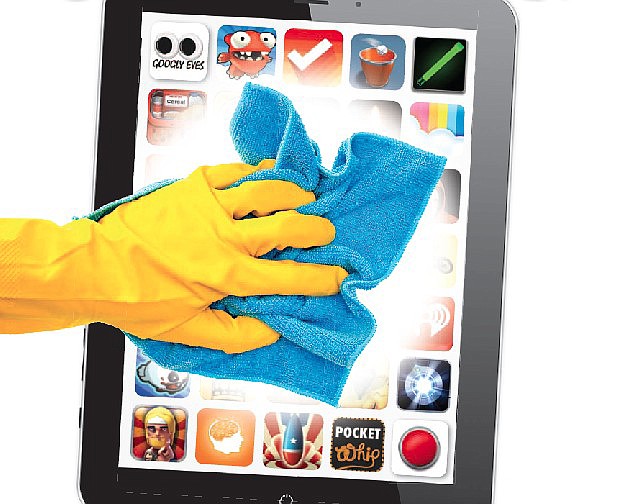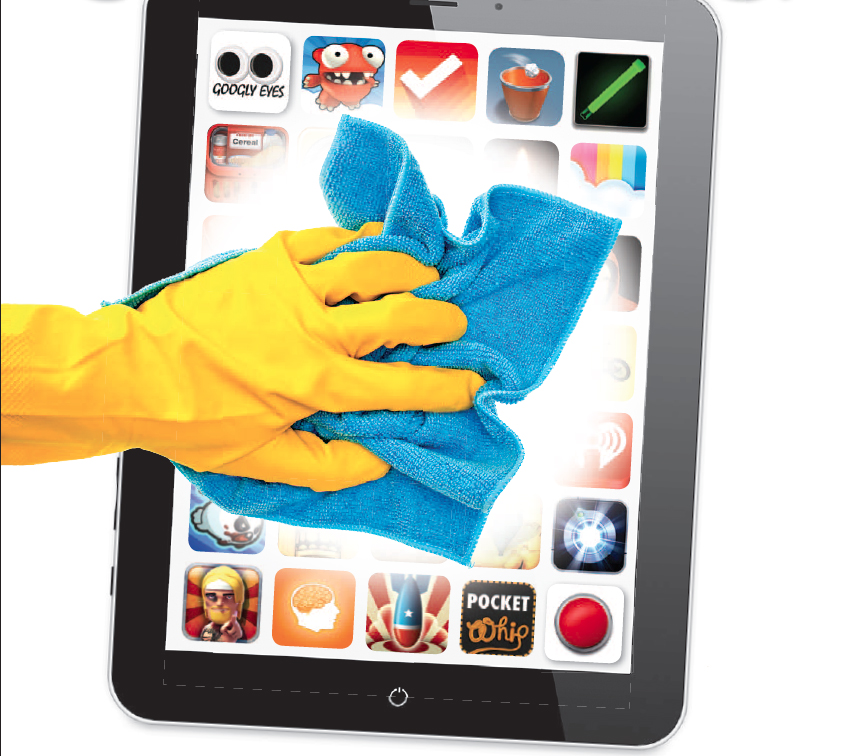Spring cleaning: Declutter your digital life
Tuesday, March 4, 2014
With spring on the horizon, some people's mental cogs might be turning over the need to box up the quilts and sweaters, their hands itching to brandish a cloth and assault winter's last dusty vestiges.
Despite the absence of harsh chemicals involved in the process, there's no reason this same urge to spruce and scour can't be applied to your digital lifestyle, too. Here are five ways to make sure your devices end up as spick and span as your house.
1. Refresh your password. As the first safeguard between your data and prying eyes, security software developer Symantec recommends rotating in new passwords for your computer, email, bank account, social network and other sensitive services once a month - three months, at the most. Stolen user information sometimes is resold to a third party, so even if an account has been hacked without your knowledge, the thief may not use it immediately. By changing your password, you could seal the breach before thieves get the opportunity.
In an online guide to developing better passwords, Symantec, the developers of the "Norton" antivirus software suite, suggests strong passwords must avoid:
• Easily guessed phrases or sequential series - "ilovemydog," "password" or "12345."
• Complete words or proper nouns - "bonanza" or "AuntBetty."
• Yours or a loved one's name, birthday or other accessible information.
• Conventional words written backwards - "nimda," "drowssap."
Instead, Symantec's guide suggests creating passwords that are at least six characters long - some services require a minimum of eight - and use a combination of upper- and lowercase letters, symbols and numbers in unlikely combinations. A common trick involves substituting numbers and symbols for letters to create an easy-to-remember but difficult-to-guess password, such as "p@7sw0rD" instead of "password."
2. Tidy up your files. Remember the days of putting important documents into bulging manila folders that you later stuffed into the hallway closet for safekeeping? That kind of storage system is on the way out. In a 2013 report, market researcher InfoTrends projects that, by 2017, about one-third of all bills and bank statements issued in the United States - about 8.6 billion documents - will be paperless.
Thanks to digital receipts being issued for everything from Amazon purchases to utility bill payments, there's more room in the cupboard these days, but keeping those digitized documents in order is still crucial. Even with built-in desktop search functions in Windows 8 and OS X, letting files pile up on your desktop in a chaotic, unruly mess is not only bad digital housekeeping, it's unnecessary - and potentially inconvenient - given the underlying organizational features of operating systems.
The tech gurus at HowToGeek.com and ScanSnapCommunity.com suggest following a few simple rules to help cut down on the clutter.
• Create your own folders for document storage instead of relying on your My Documents folder or a similar system-created archive. The programs you install tend to create subfolders in these locations, which can add to the mess you're trying to clean up.
• Decide on a system of organization that makes sense to you, such as by date (2010 files, 2011 files), by owner (My Files, My Husband's Files) or by document type (Invoices, Tax Filings). Create sub-folders to further refine your storage and to group together relevant files.
• Once you develop an organization system, stick to it and apply it to all the computers you use, whether at home or the office. Being vigilant about storing your files in the relevant locations will make it much easier to find what you need and will force you decide if a document needs to be saved or deleted.
• Create a folder to serve as an inbox for newly downloaded or created documents you know you want to keep but don't have to time to file. Make sure to clean this folder out regularly instead of allowing files to pile up and languish.
• Once you've developed a file organization system, keep your desktop clean and uncluttered. If a document or file ends up on the desktop, address it immediately.
• Back up your documents online using a free cloud storage service such as Google Docs, Dropbox or Evernote.
3. Declutter your inbox. Every year, technology market researcher The Radicati Group issues a report on global email use. In 2013, the firm estimated that 183 billion digital communiques were sent whizzing around the planet every day.
Even with well-honed filters and automatic message categorization used by services such as Gmail, that kind of traffic can lead to inboxes full of undesired and unread mail. To some, the incessant upward tick of their unaddressed message count can send them on a quest to reclaim control of their email and achieve what podcasting aficionado and productivity specialist Merlin Mann calls "Inbox Zero."
In his blog, 43 Folders, Mann writes that Inbox Zero isn't about how many messages are in the inbox, but how users can be more efficient with how they handle email. To begin the quest toward a Inbox Zero lifestyle, Mann suggests:
• Delete all emails older than 22 days and file the rest in a holding-area folder called the "DMZ" (demilitarized zone) which, because it's separate from the main inbox, will make sorting them out seem more manageable.
• Process new messages only once every couple of hours - or during a spare moment, such as while waiting in the grocery line - and don't keep your email open.
• Instead of marking all your messages as "read" to lower your message count, use your email's archive function to relocate messages you don't have time to respond to but which may be important later.
• Create a folder for emails that demand an immediate response and another for emails that can be handled later.
• Unsubscribe or otherwise remove yourself from mailing lists to which you may inadvertently have signed up.
To help you get to Inbox Zero more quickly, smartphone users can download "Mailbox" (iOS, free) or "Boomerang" (Android, free), which use gesture controls to quickly archive, delete or "snooze" messages so they return to the inbox at a predesignated time.
4. Air out your phone. According to a June study released by the Pew Research Center, more than 60 percent of Americans who use a cellphone have smartphones. Each of these, on average, has 26 apps installed on it.
Last year, Apple and Google each celebrated passing 1 million apps available in the App Store and Google Play, respectively. Given that digital smorgasbord, two dozen apps might seem like nothing to worry over, but phones often have limited storage space, so if an app or other content isn't serving a purpose, it may be best to give it the boot and reclaim your megabytes.
Keep in mind that deleting an app isn't the same as getting rid of it forever. Downloading an app links it to your account, so it can be re-downloaded later. Many feature cloud-save support for documents and other user-created content so, with the exception of some games in which deleting the app might also mean losing your progress, there's no reason to keep around software you aren't using.
Here are some tips to help determine what needs to go and what you honestly can't do without:
• Evaluate the apps installed on your device and consider the last time you used them - if ever. Has it been months since you've smashed the pigs in "Angry Birds Rio"? Has "Virtual Candle" lost its luster? Get rid of them.
• See what's taking up the most space. On an iPhone, this information can be found under settings/general/usage. Android phone users can view the same information under settings/apps.
• A long history of SMS (text messages), especially with photo and video attachments, could be taking up gigabytes of precious space. Manually deleting these messages isn't the same as permanently removing them from the device. On the iPhone, deleting texts queues them up for removal the next time the users syncs their device to a computer. Android users can remove their texts or archive them using apps such as "History Eraser" or "SMS Backup" (both free).
• Just as with software on PCs, smartphone apps often install more files than are necessary for them to function. Android users can use apps such as "Clean Master" (free) to identify and delete these residual junk files.
• Mobile device cameras are taking better photos than ever, but at full resolution, these images can be hefty. By syncing their photo library to a cloud-based storage service such as Photostream (iPhone) or Picasa (Android devices), users can keep hundreds of megabytes worth of photos of Aunt Lilly's birthday without taking up valuable space on their phone.
5. Back it up. In many states, it's illegal to drive a car without insurance, but as many as 30 percent of computer users have never insured their data by backing up their computers, according to a 2013 survey conducted by market researcher Harris Interactive.
That's a problem, says Donald Sayers, owner of Chattanooga-based computer and smartphone repair service iFixie.
"Backup is a big one; a lot of people don't do that," he says. "I've seen three dead hard drives this week. Backup is the most important thing you can do. Data recovery can cost thousands, depending on the damage, and it may not be recoverable."
According to the Harris Interactive survey, 48 percent of those who do backup their systems only do so once a year or longer. In that time, they could have accumulated thousands of photos, videos and documents that could be wiped out. According to a 2010 survey by ConsumerStatistics.org, two-thirds of PC users lose pictures or other files off their computers at some point.
Instead of using a built-in, internal hard drive as a backup, Sayers recommends an external hard drive with a larger storage capacity than your computer so you can save revisions of files and keep ones you may accidentally delete.
"One copy on one device is not a backup," he says.
Since they are portable, external drives allow you to take your data with you on vacation in case of theft, fire or other mishap. Once they have a drive, Sayers says, Mac users should set up an automatic weekly backup schedule for their system using the built-in feature on OS X. PC users should set up a similar schedule using the third-party software that comes with their drive.
For those who really want to protect their data, Sayers suggests an off-site, automated backup service such as Carbonite or CrashPlan. These annual subscription services offer unlimited data backup for about $60.
Contact Casey Phillips at cphillips@timesfreepress.com or 423-757-6205. Follow him on Twitter at @PhillipsCTFP.

